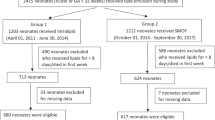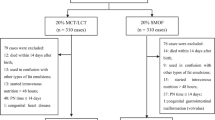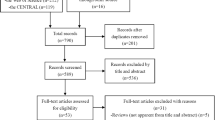Abstract
Objective
To compare neurodevelopmental outcomes of extremely preterm children who received soy-medium chain triglycerides-olive-fish oil-containing lipid emulsion (SMOF-LE) vs soy-based LE.
Study design
We conducted a pre-post comparative cohort study of children born < 29 weeks’ gestation who received > 7 days of LE. Outcomes were mortality/significant neurodevelopmental impairment (NDI), mortality/any NDI, significant NDI, any NDI, and individual components of NDI.
Results
Among children with follow-up data (Intralipid: n = 340/442, 77%; SMOF-LE: n = 214/286, 75%), baseline characteristics were comparable except for postnatal steroids. There was no significant difference in death/significant NDI between groups. Adjusted odds of death/any NDI [0.68 (95% CI 0.48, 0.97)], any NDI [0.64 (95% CI 0.44, 0.93)] and Bayley-III language score < 85 and <70 were significantly lower in the SMOF-LE group.
Conclusions
In extremely preterm children, a change from soy-based LE to SMOF-LE was not associated with deleterious effect on neurodevelopmental outcomes and may have been associated with some improvement.
This is a preview of subscription content, access via your institution
Access options
Subscribe to this journal
Receive 12 print issues and online access
$259.00 per year
only $21.58 per issue
Buy this article
- Purchase on Springer Link
- Instant access to full article PDF
Prices may be subject to local taxes which are calculated during checkout

Similar content being viewed by others
Data availability
The datasets generated and analyzed during the current study are with the corresponding author and may be available on reasonable request.
References
Vohr BR. Neurodevelopmental outcomes of extremely preterm infants. Clin Perinatol. 2014;41:241–55.
Saugstad OD. Update on oxygen radical disease in neonatology. Curr Opin Obstet Gynecol. 2001;13:147–53.
Thibeault DW. The precarious antioxidant defenses of the preterm infant. Am J Perinatol. 2000;17:167–82.
Sharda B. Free radicals: emerging challenge in environmental health research in childhood and neonatal disorders. Int J Environ Res Public Health. 2006;3:286–91.
Grimm H, Mertes N, Goeters C, Schlotzer E, Mayer K, Grimminger F, et al. Improved fatty acid and leukotriene pattern with a novel lipid emulsion in surgical patients. Eur J Nutr. 2006;45:55–60.
Lapillonne A, Groh-Wargo S, Gonzalez CH, Uauy R. Lipid needs of preterm infants: updated recommendations. J Pediatr. 2013;162:S37–47.
Uauy R, Hoffman DR, Peirano P, Birch DG, Birch EE. Essential fatty acids in visual and brain development. Lipids. 2001;36:885–95.
Calder PC, Adolph M, Deutz NE, Grau T, Innes JK, Klek S, et al. Lipids in the intensive care unit: recommendations from the ESPEN expert group. Clin Nutr. 2018;37:1–18.
Torgalkar R, Dave S, Shah J, Ostad N, Kotsopoulos K, Unger S, et al. Multi-component lipid emulsion vs soy-based lipid emulsion for very low birth weight preterm neonates: a pre-post comparative study. J Perinatol. 2019;39:1118–24.
Richardson DK, Corcoran JD, Escobar GJ, Lee SK. SNAP-II and SNAPPE-II: simplified newborn illness severity and mortality risk scores. J Pediatr. 2001;138:92–100.
1Albers CA, Grieve AJ. Test review: Bayley, N. (2006). Bayley scales of infant and toddler development–third edition. San Antonio, TX: Harcourt Assessment. J Psychoeduc Assess 2007;25:180–90.
Synnes A, Luu TM, Moddemann D, Church P, Lee D, Vincer M, et al. Determinants of developmental outcomes in a very preterm Canadian cohort. Arch Dis Child Fetal Neonatal Ed. 2017;102:F235–5.
Palisano R, Rosenbaum P, Walter S, Russell D, Wood E, Galuppi B. Development and reliability of a system to classify gross motor function in children with cerebral palsy. Dev Med Child Neurol. 1997;39:214–23.
Tyson JE, Parikh NA, Langer J, Green C, Higgins RD. Intensive care for extreme prematurity—moving beyond gestational age. New Engl J Med. 2008;358:1672–81.
Dukhovny D. ‘Does _ predict neurodevelopmental impairment in former preterm infants?’ Is this the right question to be asked? J Perinatol. 2017;37:467–8.
Kawakita E, Hashimoto M, Shido O. Docosahexaenoic acid promotes neurogenesis in vitro and in vivo. Neuroscience. 2006;139:991–7.
Vreugdenhil M, Bruehl C, Voskuyl R, Kang J, Leaf A, Wadman W. Polyunsaturated fatty acids modulate sodium and calcium currents in CA1 neurons. Proc Natl Acad Sci. 1996;93:12559–63.
Bazan NG. Neuroprotectin D1 (NPD1): a DHA-derived mediator that protects brain and retina against cell injury-induced oxidative stress. Brain Pathol. 2005;15:159–66.
Clandinin M, Chappell J, Heim T, Swyer P, Chance G. Fatty acid utilization in perinatal de novo synthesis of tissues. Early Hum Dev. 1981;5:355–66.
Martinez M. Tissue levels of polyunsaturated fatty acids during early human development. J Pediatr. 1992;120:S129–38.
Makrides M, Gibson RA, McPhee AJ, Collins CT, Davis PG, Doyle LW, et al. Neurodevelopmental outcomes of preterm infants fed high-dose docosahexaenoic acid: a randomized controlled trial. JAMA. 2009;301:175–82.
McNamara RK, Carlson SE. Role of omega-3 fatty acids in brain development and function: potential implications for the pathogenesis and prevention of psychopathology. Prostaglandins Leukot Essent Fat Acids. 2006;75:329–49.
Swanson D, Block R, Mousa SA. Omega-3 fatty acids EPA and DHA: health benefits throughout life. Adv Nutr. 2012;3:1–7.
Alshweki A, Munuzuri AP, Bana AM, de Castro MJ, Andrade F, Aldamiz-Echevarría L, et al. Effects of different arachidonic acid supplementation on psychomotor development in very preterm infants; a randomized controlled trial. Nutr J. 2015;14:101.
Hadley KB, Ryan AS, Forsyth S, Gautier S, Salem N. The essentiality of arachidonic acid in infant development. Nutrients. 2016;8:216.
Zhao Y, Wu Y, Pei J, Chen Z, Wang Q, Xiang B. Safety and efficacy of parenteral fish oil–containing lipid emulsions in premature neonates. J Pediatr Gastroenterol Nutr. 2015;60:708–16.
Najm S, Lofqvist C, Hellgren G, Engstrom E, Lundgren P, Hard AL, et al. Effects of a lipid emulsion containing fish oil on polyunsaturated fatty acid profiles, growth and morbidities in extremely premature infants: a randomized controlled trial. Clin Nutr ESPEN. 2017;20:17–23.
Gui L, Loukas S, Lazeyras F, Hüppi PS, Meskaldji DE, Tolsa CB. Longitudinal study of neonatal brain tissue volumes in preterm infants and their ability to predict neurodevelopmental outcome. NeuroImage. 2019;185:728–41.
Benavente-Fernández I, Siddiqi A, Miller SP. Socioeconomic status and brain injury in children born preterm: modifying neurodevelopmental outcome. Pediatr Res. 2020;87:391–8.
Benavente-Fernández I, Synnes A, Grunau RE, Chau V, Ramraj C, Glass T, et al. Association of socioeconomic status and brain injury with neurodevelopmental outcomes of very preterm children. JAMA Netw Open. 2019;2:e192914.
Guthrie G, Premkumar M, Burrin DG. Emerging clinical benefits of new‐generation fat emulsions in preterm neonates. Nutr Clin Pract. 2017;32:326–36.
Nehra D, Fallon EM, Potemkin AK, Voss SD, Mitchell PD, Valim C, et al. A comparison of 2 intravenous lipid emulsions: interim analysis of a randomized controlled trial. J Parenter Enter Nutr. 2014;38:693–701.
Acknowledgements
The authors thank Heather McDonald-Kinkaid, Ph.D., of the Maternal-infant Care Research Centre (MiCare) at Mount Sinai Hospital, Toronto, ON, Canada, for editorial support in preparing this paper. MiCare is supported by a Canadian Institutes of Health Research Team Grant (CTP 87518), the Ontario Ministry of Health and Long-Term Care, and the participating hospitals.
Funding
No specific funding was received for the project described in this paper. PSS holds an Applied Research Chair in Reproductive and Child Health Services and Policy Research from the Canadian Institutes of Health Research (APR-126340).
Author information
Authors and Affiliations
Contributions
RT and PSS conceptualized and designed the study, drafted the initial paper, and reviewed and revised the paper. JS, SD, NO, KK, SU, and EK participated in study design and data interpretation and reviewed and revised the paper. JY analyzed the data and reviewed and revised the paper. All authors approved the final paper as submitted and agree to be accountable for all aspects of the work including ensuring that questions related to its accuracy or integrity are appropriately investigated and resolved.
Corresponding author
Ethics declarations
Conflict of interest
The authors declare that they have no conflict of interest.
Ethical approval
This study was approved by the Sinai Health Research Ethics Board, Toronto, ON, Canada.
Additional information
Publisher’s note Springer Nature remains neutral with regard to jurisdictional claims in published maps and institutional affiliations.
Rights and permissions
About this article
Cite this article
Torgalkar, R., Shah, J., Dave, S. et al. Fish oil-containing multicomponent lipid emulsion vs soy-based lipid emulsion and neurodevelopmental outcomes of children born < 29 weeks’ gestation. J Perinatol 40, 1712–1718 (2020). https://doi.org/10.1038/s41372-020-0710-5
Received:
Revised:
Accepted:
Published:
Issue Date:
DOI: https://doi.org/10.1038/s41372-020-0710-5



